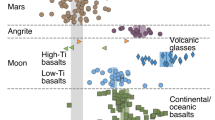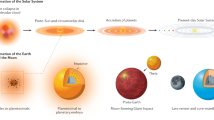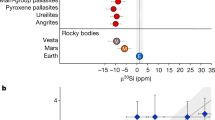Abstract
IN many meteorites, the abundances of the heavy isotopes of Xe are enriched relative to solar Xe. In some cases, this enrichment results from the addition of fission products from U and Pu. In some carbonaceous chondrites, however, the isotopic enrichment pattern of the heavy Xe is inconsistent with the measured Xe yield patterns of U, Pu, Cm, and Cf fission. The lack of correlation between heavy Xe enrichment and U concentration in separated mineral phases also argues that the Xe is not due to fission of an element whose chemical properties are similar to U. It has been suggested that this enrichment resulted from the decay of a superheavy element1,2. An experimental test of this hypothesis is proposed here.
This is a preview of subscription content, access via your institution
Access options
Subscribe to this journal
Receive 51 print issues and online access
$199.00 per year
only $3.90 per issue
Buy this article
- Purchase on Springer Link
- Instant access to full article PDF
Prices may be subject to local taxes which are calculated during checkout
Similar content being viewed by others
References
Anders, E. & Heymann, D. Science 164, 821–823 (1969).
Dakowski, M. EPSL 6, 152–154 (1969).
Lewis, R., Srinivasan, B. & Anders, E. Science 190, 1251–1262 (1975).
Lewis, R., Gros, J. & Anders, E. JGR 82, 5, 779–792 (1977).
Anders, E., Higuchi, H., Gros, J., Takahashi, H. & Morgan, J. Science 190, 1262–1271 (1975).
Flynn, G., Fraundorf, P., Shirck, J. & Walker, R. in Lunar Science VIII 305–307 (The Lunar Science Institute, 1977).
Macdougall, J. paper presented at Eighth Lunar Science Conference (1977).
Hyde, E. The Nuclear Properties of the Heqvy Elements III: Fission Phenomena (Prentice-Hall, Eaglewood Cliffs, 1964).
Scheinin, N., Lugmair, G. & Marti, K. Meteoritics 11, 357–358 (1976).
Richard, P., Shimizu, N. & Allegre, C. J. EPSL 31, 269–278 (1976).
McCulloch, M., Papanastassiou, D. & Wasserburg, G. Meterontics 11, 331–332 (1976).
Rao, M. Nuclear Phys. A 140, 69–73 (1970).
Drozd, R., Morgan, C., Podosek, F., Poupeau, G., Shirck, J. & Taylor, G. Astrophys. J. 212, 567–580 (1977).
Loubet, M. & Allegre, C. J. Behavior of Rare-Earth Elements in the Oklo Reactor, GCA (in the press).
Mason, B. Handbook of Elemental Abundances in Meteorites (Gordon and Breach, New York, 1971).
Friedlander, G., Kennedy, J. & Miller, J. Nuclear and Radiochemistry, Wiley, Chichester (1964).
Wahl, A. in Physics and Chemistry of Fission 1, 317–331 (IAEA, Vienna, 1965).
Author information
Authors and Affiliations
Rights and permissions
About this article
Cite this article
FLYNN, G., LOUBET, M. Superheavy element fission hypothesis in carbonaceous chondrites. Nature 268, 717–719 (1977). https://doi.org/10.1038/268717a0
Received:
Accepted:
Issue Date:
DOI: https://doi.org/10.1038/268717a0
This article is cited by
-
Primaeval melting of the Moon
Nature (1977)
Comments
By submitting a comment you agree to abide by our Terms and Community Guidelines. If you find something abusive or that does not comply with our terms or guidelines please flag it as inappropriate.



